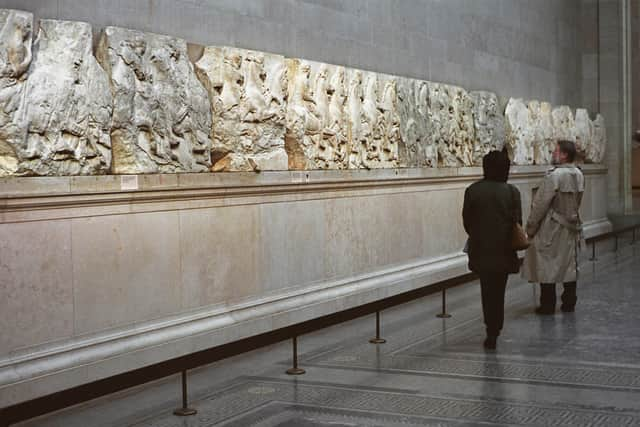Elgin Marbles: How Britain got hold of Parthenon Sculptures as UK/Greece row deepens
and live on Freeview channel 276
Tensions over the ownership of the Elgin Marbles is showing no signs of going away. Prime Minister Rishi Sunak cancelled a meeting with his Greek counterpart Kyriakos Mitsotakis after it came to light he would ask for them to be returned to Greece.
Also known as the Parthenon Sculptures, they are a collection of more than 30 ancient stone sculptures from Greece held in the British Museum. The UK government has said ownership of the marbles is “settled” and they're British.
Advertisement
Hide AdAdvertisement
Hide AdHowever, Mitsotakis told BBC’s Sunday With Laura Kuenssberg programme on Sunday (November 26) that the continued presence of the Elgin Marbles in the British Museum is like cutting the “Mona Lisa in half”. The British Museum is banned by law from giving the sculptures back to Greece, but its leaders have held talks with Greek officials about a compromise, such as a long-term loan. But Sunak’s government appears to have hardened its position.


What are the Elgin Marbles?
The Marbles are more than 30 ancient stone sculptures mainly from the Parthenon in Greece. They date back more than 2,000 years and were largely built between 447 - 438 BC. They represent a key part of Greece's cultural heritage.
The Parthenon in Athens is a temple built by the ancient Greeks in the 5th century BC. There are also pieces from other temples in the area built around the same time. But there are some which date back much further and are from the Treasury of Atreus in Mycenae. That was constructed between 1300 and 1250 BC, making them more than 3,000 years old.
The Elgin Marbles decorated the walls and grounds of ancient temples and depicted scenes from Greek history and mythology. The biggest stretches for 75 metres, showing a procession for the birthday of the goddess Athena.
Advertisement
Hide AdAdvertisement
Hide AdHow did Britain gain possession of the Elgin Marbles?
It is known that the Parthenon marbles (Or Parthenon Sculptures) were removed from the Parthenon temple in Athens, Greece back in 1801 by Lord Elgin. The British diplomat, then the ambassador to the Ottoman Empire which ruled Greece at the time, oversaw the removal and shipping of the marbles to the UK in 170 crates. Lord Elgin insisted he had permission to remove the sculptures from the Ottomans. However, the original letter giving him permission has been lost and the wording of what remains is disputed by some. The British government bought the sculptures from Lord Elgin in 1816 for display in the British Museum. His actions were investigated by Parliament and deemed legal in 1816. But when Greece became independent in 1835 the government asked the UK to return them.
The Marbles have been in the British Museum since 1832 - the same museum that was embroiled in controversy earlier this year when it was revealed around 2,000 artefacts had been stolen from the UK institution - leading to its former director Hartwig Fischer quitting in disgrace.
Transport Secretary Mark Harper said that “the government set out its position about the Elgin Marbles very clearly, which is they should stay as part of the permanent collection of the British Museum”. Mitsotakis was offered a meeting with Deputy Prime Minister Oliver Dowden, which he declined. On November 28, following the cancellation of the meeting, Conservative Home posted on the social media platform X, formerly known as Twitter: “Giving away the Elgin Marbles would strike at the very foundations of the British Museum.” But instead of attaching a picture of the British Museum, it attached a photo of the Natural History Museum, which users were very quick to point out.
Comment Guidelines
National World encourages reader discussion on our stories. User feedback, insights and back-and-forth exchanges add a rich layer of context to reporting. Please review our Community Guidelines before commenting.
